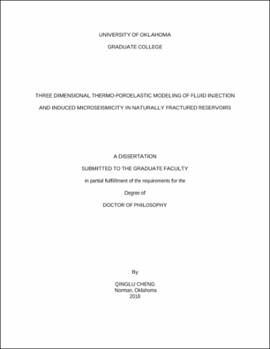| dc.description.abstract | Interests in naturally fractured reservoirs have grown rapidly in recent years due to the increasing energy needs. Understanding the behavior of naturally fractured reservoirs would be beneficial for a variety of engineering applications, including enhanced oil recovery in the petroleum industry, reservoir stimulation in enhanced geothermal systems, salt water disposal, carbon dioxide storage, and nuclear waste management. In naturally fractured reservoirs with low permeability rock matrix, natural fractures provide primary pathways for fluid flow and dominate the flow behavior of the fractured medium. Fractures are stress sensitive. They could dilate, slip in shear, and propagate possibly as a result of stress changes caused by fluid injection operations, thereby increasing fracture aperture and permeability, and influencing reservoir performance. Injection into fractured reservoirs could also induce seismicity, which is often attributed to shear slippage on fractures.
In this study, we developed a three dimensional fully coupled thermo-poroelastic model which is integrated with a stochastic natural fracture network to simulate the response of fractured reservoirs to fluid injection. Fluid injection induces significant perturbations in the pore pressure, temperature and stress fields within a reservoir, and involves coupling between fluid flow, heat transfer, and mechanical deformation. This coupling process is modeled using a linear theory of thermo-poroelasticity and solved using a finite element method. The presence of natural fractures is taken into consideration by implementing a fracture network model into the coupled thermo-poroelastic model. A discrete fracture network is generated based on stochastic descriptions of fracture distribution parameters, including fracture density, size and orientation. The available fracture geometry includes penny-shaped circular fractures, elliptical fractures and rectangular fractures. Since the calculations of flow in non-circular fractures require additional mathematical treatments (Long et al. 1985) and the available solutions to heat transfer in the non-circular fractures are also limited, therefore, the commonly used penny-shaped circular fracture is modeled in this work. The permeability of the fractured rock is estimated using an equivalent permeability approach. The fracture permeability can increase by shear dilation and fracture propagation. For numerical simulations of fracture slip, two most widely used friction models are incorporated, including a constant friction model and a rate-and-state friction (RSF) model that considers the dependence of friction on the slip velocity and the past sliding history. The coupled FEM is solved for pressure, temperature, and deformation in the equivalent continuum medium formed by the fractures and the rock matrix. Knowing the flows and heads within the fracture network and the intersections between fractures, local pressure distribution on individual fracture planes is solved analytically based on an image theory (Rahman et al. 2002). Heat transfer within the interconnected fracture network is modeled by a flow pipe network model considering both the convection via fracture flow and the conduction between adjacent rock mass and the fluid in the fracture. Stress dependent fracture deformation behavior including opening, shear dilation, and possible propagation is considered, and the associated changes in fracture aperture and fracture network geometry are updated for permeability in the coupled FEM. The potential of microseismicity induced by fracture shear slippage is also modeled. The developed model is verified against analytical solutions and previously published numerical results.
This model is first used to simulate cold water injection into a naturally fractured reservoir to examine its capability of analyzing the dynamic reservoir response during injection. Results show that the fluid and heat flow within the fractured reservoir are primarily dominated by the connected fracture network. The results also indicate that the overall reservoir permeability enhancement can be attributed to the combined effects of fracture opening, shear slippage, and propagation. A sensitivity study is carried out for investigating the effect of various parameters on the reservoir performance and on the occurrence of induced seismicity during injection. The results show that the injection response of a naturally fractured reservoir is a complex process controlled by multiple factors, including the properties of fracture network, in-situ stress conditions, rock matrix permeability, the properties of injecting fluid, injection scheme and injection temperature.
The developed model has a wide variety of engineering applications in naturally fractured rock. Two application examples are present in this dissertation. The first application example is the simulation of reservoir stimulation in the Newberry EGS Demonstration. Field data on the fracture network and in-situ stress and laboratory data on rock and fracture properties are used in model construction. The simulated injection profile, the evolution of permeability and induced microseismic events have good agreements with field observations. Simulation results also show the perturbation and rotation of the in-situ stress field adjacent to the injection well, which helps to explain the discrepancy between the stress models derived pre-injection and inverted from seismic data post-injection.
The second application example is a large scale simulation of the 12 years long term wastewater injection in central Oklahoma. A conceptual model is built based on the available data on the fault geometry, regional stress fields, and well injection history. Simulation results show that during injection, the elevated pore pressure can migrate downward from the Arbuckle injection layer into the deeper crystalline basement via the fault system. For nearly critical fractures, a small elevated pressure is sufficient to cause shear slippage of fractures along the optimally oriented Meeker-Prague fault and potentially induce seismicity. Injection strategies of capping the total injected volume, reducing the injection rate, and restricting the injection depth are proposed to reduce the size of the potentially induced seismicity.
The numerical model developed in this study is shown to have the capability of analyzing the dynamic reservoir response during fluid injection. It is useful for the design and evaluation of injection plans in naturally fractured reservoirs. | en_US |
